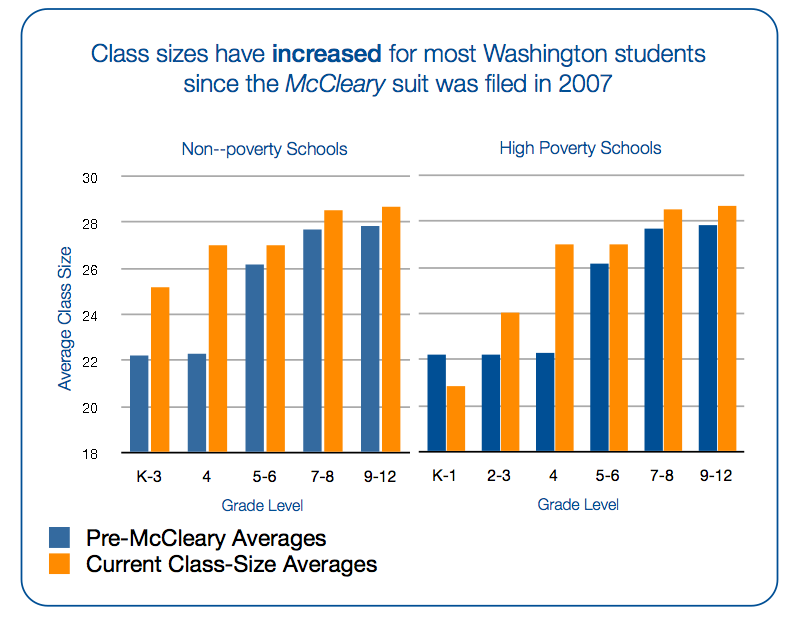FAQs
Here are some frequently asked questions concerning Initiative 1351.
Though not enjoyed by all, we live in an era of prosperity in one of the richest regions on earth. We take pride in our position as a center of innovation and wealth in the new information economy. Our state doesn’t suffer from a lack of resources, but rather a lack of vision and commitment. 1351 gives lawmakers four years to find the means to move Washington from 47th out of 50 states to about the national average for class size and school staffing.
1351 is part and parcel to compliance. The state Supreme Court’s McCleary decision and subsequent orders require the Legislature to meet its paramount duty under the state constitution to amply fund schools. The decision covers the full range of funding requirements including school employee pay, materials, supplies, transportation, and, of course, class size. How could the Legislature possibly meet its duty to students while leaving them in some of the most over-crowded classrooms in the country?
Teachers, parents, students and the public at large know that smaller class sizes at every grade level are implicit to McCleary compliance. And by passing 1351, voters have made that explicit. The act states that it is the intent of voters to reduce class sizes “in order to comply with the constitutional requirements to amply fund basic education and with the Washington Supreme Court decision in McCleary ...”
Of course! Research evidence and common sense tell us that class size matters for kids at every level. Just as beginning learners can’t develop critical thinking skills when they are competing with 27 other students for attention from their teacher, 34 high school students can’t master the principles of chemistry when they are crowded into a science lab designed for 22.
State Supt. Randy Dorn explained the need for upper-grade class-size reduction this way recently in the Seattle Times, “We expect a lot from students today, and rightly so. Rigorous course work helps prepare our kids for success in the high-tech economy. High-school math 5and science are hard, and in many cases students taking them receive full college credit. It’s inspiring to see kids challenged and achieving more than ever before. But this is only possible when teachers understand their students as individual people, when they know their interests and how they see the world, and then make connections that help students understand difficult material.”
No. For most students in Washington, class sizes have increased significantly since the McCleary school-funding lawsuit was filed in January 2007. In a one-day special session in 2010, lawmakers increased K-4 class sizes, and in 2012, lawmakers repealed Initiative 728, eliminating the Student Achievement Fund which paid for smaller K-12 class sizes. Though lawmakers established a goal nearly five years ago of K-3 class size averages of 17 students, the only actual relief came in 2013 when high-poverty K-1 average class sizes were reduced to 21 students.

Some school districts currently have the physical space they would need for smaller class sizes, and others would need more classrooms. That’s one reason I-1351 phases in reductions over four years, giving districts and the state time to plan and prepare.
I-1351 allows school districts without enough classroom space to use the class-size reduction funds for additional staff that provide direct services to students. This means, for example, two teachers might serve the students in one classroom, additional teaching assistants might be hired, or summer-school programs might be offered. While interim alternatives such as these may not be ideal, they will support student learning while long-term facilities issues are being resolved.
This is a total falsehood. As a result of the passage of I-1351, 15,000 classroom teaching positions will be filled in the next four years. And funding will go to school districts for staff that are vital to student learning: school nurses, librarians, guidance counselors, school safety officers, and teacher assistants. Opponents call them “bureaucrats” – we call them the people who, along with teachers, help our children learn and keep our schools running safely and smoothly.
Class Size Counts, a statewide, grass-roots coalition of parents, teachers, students and community leaders successfully sponsored I-1351.
Class Size Counts is committed to seeing that the new law is fully and properly implemented so that all students benefit from smaller class sizes. To learn more, visit www.ClassSizeCountsWA.com
No, the class-size reductions called for by I-1351 are inherent to McCleary compliance. During the McCleary trial, the legislature assured the court that it would move forward a comprehensive plan for ample school funding, establishing the Quality Education Council (QEC) to recommend such things as K-12 class-size standards to ensure learning opportunity for all kids. The QEC class-size standards are the basis of I-1351; they are the improvements the legislature’s own, bi-partisan panel has deemed necessary.
In most schools, average class sizes are:
Grades K-3: 25.23
Grades 4-6: 27
Grades 7-8: 28.53
Grades 9-12: 28.74
In high-poverty schools, class sizes in the primary grades are lower:
Grades K-1: 20.85
Grades 2-3: 24.1
Individual class sizes vary from these averages, and it is not uncommon to find beginning readers competing with 27 other students for the attention of their teacher, for example, or 34 high school students sharing a science lab designed for 25.
Over the past year, Class Size Counts collected actual class-size counts from over 5000 classrooms from across the state. You can see the findings at http://classsizecountswa.com/classes-counted
By 2018, class sizes in grades K-3 would average 17, and class sizes in grades 4-12 will average 25. The new law provides additional relief in schools serving the highest numbers of children living in poverty. I-1351 also provides for additional school counselors, librarians, nurses, teaching assistants and other student support staff.

